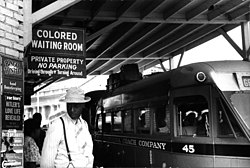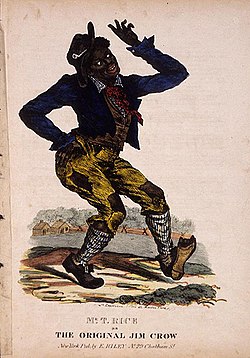History of Tennessee/Jim Crow Laws and Customs (1886-1955)
Jim Crow Laws
[edit | edit source]Between 1886 and 1955, Tennessee was one of many Southern states to enact a set of racial black- codes that were referred to as Jim Crow laws. White members of communities across the state of Tennessee, other southern states and even those who lived beyond the south, began to erect a number of barriers between themselves and members of other racial and ethnic groups, particularly African Americans that initiated extreme segregation and exclusion.

Under these Jim Crow laws, white people were seen as first-class citizens. Comparatively, African Americans were seen as inferior, second class citizens who did not deserve freedom or rights that they previously would have expected after the eradication of slavery. The Jim Crow Laws were able to go around the legislation during the time they were put into place to ensure their laws were applicable. The law of 1869 declared that no citizen could be excluded from the University of Tennessee because of race or color. While still including this law, the Jim Crow laws mandated that instructional facilities for black students be separated from those of white students, schools for the black were referred to as “Jim Crow Schools” and received a noticeably less amount of consideration and funding compared to white schools.

The legal system worked against all black citizens, the positions of police and judges were taken up by ex-confederate soldiers which made it almost impossible for African Americans to win any court systems and ensured the blacks all became victims of these black codes customs that promoted segregation. These laws dictated all aspects of a black individual's daily life including who may marry whom, who may live where, who may study where, who may work where, who may vote where, and who may travel how. They mainly consisted of developing “separate but equal” facilities to create a division between African Americans and their white counterparts, this included separate taxis, drinking fountains, prison cells, sports teams, bathrooms, and, as previously mentioned, schools.
Origin of Jim Crow
[edit | edit source]The character “Jim Crow” was once known as a popular folk trickster among black slaves but later turned into a term to describe racist segregation laws, rules, and customs. The name Jim Crow became an insult towards African Americans after Thomas D. Rice created a racist theatre character referred to as Jim Crow that gained quick success and popularity amongst whites.

After this theatre character gained attention, the name became an offensive term aimed towards blacks and later became the name of the racial laws of segregation that took away rights from African Americans which were once granted to them through the 13th, 14th, and 15th Amendments that freed millions of slaves, defined citizenship and protected voting rights.
After these amendments, white people felt that black individuals required more restriction and less freedom. They then created the Jim Crow laws and customs to outline when, where and how these newly freed slaves could work, created indentured servants out of the African Americans (practically made them slaves again), took away their voting rights, and controlled how or where they lived and traveled. The Jim Crow laws created an entire system based on segregation and enshrined African Americans as “second class” citizens.
Jim Crow Etiquette and Customs
[edit | edit source]Not only was Jim Crow a set of racist laws against African Americans, but it also included a particular set of etiquette and customs that outlined the appropriate interactions between blacks and whites as well as blacks with one another. This set of customs and etiquette would go so far as to say that blacks were expected to step aside for passing whites on the sidewalk. Other forms of etiquette that were given attention during this time included that blacks were only to be introduced to white individuals; meaning, a white should never be introduced to a black, whites should not use courtesy titles when referring to blacks (Mr., Mrs., Miss.), but blacks must use such titles when referring to whites as a sign of respect, if a car was being driven by a white person, they were given the right of way at intersections and if a black individual was in the vehicle with them, they had to sit in either the back seat or the trunk.
These Jim Crow laws and the Jim Crow customs were enforced through violence, both real violence and the threat of violence. Any blacks who violated Jim Crow laws and etiquette risked their property, jobs, freedom (the degree of which they had), and even their lives. It was evident that the Jim Crow laws stood to benefit white individuals.
The Jim Crow Coach
[edit | edit source]A “Jim Crow” coach was a separate train car that was specifically for African Americans. Within the slave states, slaves were required to ride in the Jim Crow car amongst other free black individuals when they had to travel somewhere with their owners. This isolated coach was meant to show the inferiority of one class of people over another. In these Jim Crow coaches, the trains were supposed to show equal treatment to both white and black people which created a "separate but equal" mentality. Everyone who rode the train was required to pay the same train fare in order to make everyone more equal. If Caucasian people received something; food, seating, washrooms, then black people must be able to obtain those things as well if they wished to. If black people did not receive equal treatment then whoever mistreated them, the conductor or server, could be charged.
There was a high degree of racism at this time causing black people to experience unjust treatment on these trains even with the implementation of these laws. For example, African American people were not allowed to leave the Jim Crow sections of the trains. However, white people were able to go wherever they pleased. Sometimes white people would use the Jim Crow car for their own space and many individuals would use it as a smoking car. The cars were dirty, and the conductor would often leave his stuff on a few of the seats in the Jim Crow coach. In the 1920s and 1930s, the black community was increasing in Tennessee and full-length Jim Crow coaches were being developed. Full-length Jim Crow cars were much longer and more spacious than the original Jim Crow sections on trains. Black individuals who refused to ride in the Jim Crow coaches were subject to violence and arrested immediately.
End of Jim Crow
[edit | edit source]The end of Jim Crow started after World War II in 1945 where a number of anti-segregation laws came into effect the following years due to an increase in civil right activities in black communities. By 1955 the Jim Crow laws were virtually no longer in effect.
